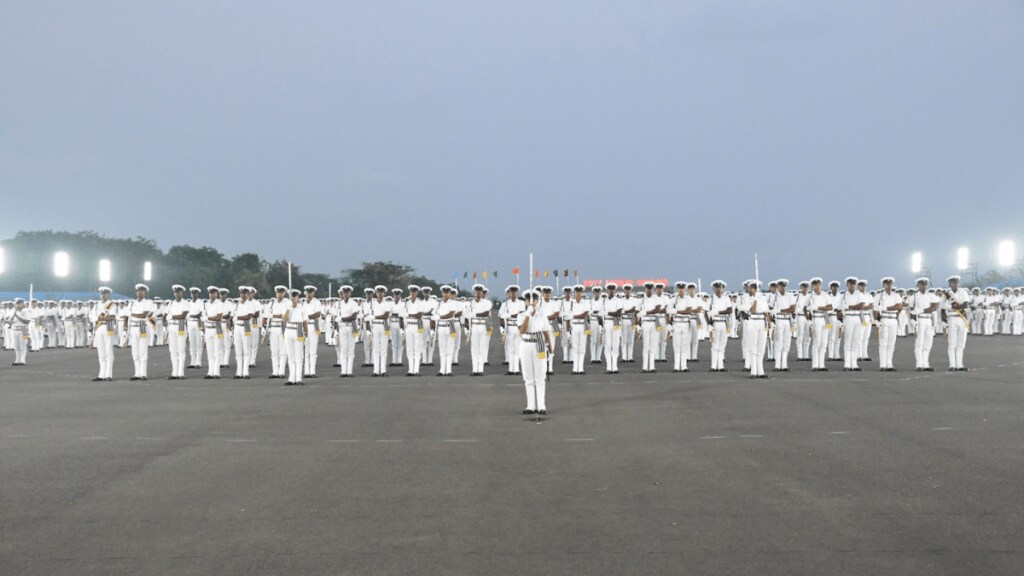In a significant milestone for the Indian Navy, Admiral Dinesh K Tripathi, Chief of the Naval Staff, reviewed the Passing Out Parade (POP) of the fourth batch of Agniveers at INS Chilka earlier today. The post-sunset ceremony witnessed 1,390 Agniveers, including 216 women, taking the ‘Antim Pag’ (Final Step) from the hallowed portals of INS Chilka. Alongside the Naval Agniveers, 330 Coast Guard Naviks also passed out on this occasion.
The event, which marked the culmination of 16 weeks of rigorous training, was conducted by Vice Admiral V Srinivas, Flag Officer Commanding-in-Chief, Southern Naval Command. Proud families of the passing-out Agniveers, eminent veterans, and sports personalities were present to witness this momentous event.
The Passing Out Parade signified the successful completion of ab initio training and marked the beginning of the Agniveers’ new journey in the Combat Ready, Credible, Cohesive, and Future-Ready Indian Navy. The training at INS Chilka, the premier sailors’ training establishment of the Indian Navy, encompassed a comprehensive curriculum designed to transform recruits into Sea Warriors.
This included academic instruction, physical training, swimming, small arms handling, cyber security, and naval orientation. The program was meticulously crafted to develop the mental and physical faculties essential for a career at sea.
Upon completing their ab initio training, Agniveers proceed to professional training in their assigned trades at various Naval Training Establishments. This phase is crucial as it prepares them for the specific technical and non-technical roles they will undertake aboard frontline warships. These roles range from operating advanced equipment such as radars, sonars, and communications systems to handling weapons like missiles, guns, and rockets.
More than a year has passed since the Indian Navy welcomed its first batch of Agniveers, and these young sailors have since been deployed across a wide spectrum of maritime security operations. The integration has been smooth, with Agniveers meeting the high standards expected of naval personnel. The Navy’s approach to its training and deployment has ensured that the operational efficiency of its ships remains unaffected, with many commanders reporting no issues with the performance of Agniveer on the frontline vessels.
“Agniveers are now a common sight aboard our major warships, participating actively in exercises, training, and daily operations alongside their more seasoned colleagues. Despite being relatively new to the sea, these recruits have shown remarkable enthusiasm and commitment, reminiscent of the sailors who came before them,” said a senior official from the defence and security establishment. “Their on-the-job training is as rigorous as ever, ensuring they are fully prepared for their duties at sea,” the source added.
The Navy’s divisional system has played a vital role in this integration, embedding Agniveers into ship crews rapidly and effectively. These recruits are treated as full members of their teams, engaging in all aspects of naval operations—from preparing weapon systems to maintaining machinery and conducting complex evolutions like ammunitioning and towing. The Navy has also strongly emphasised addressing the individual needs of Agniveers during their training and operational duties.
“Agniveers have excelled not only in their professional roles but also in academic and physical training. Reports from our training schools highlight several individuals who have surpassed expectations, particularly in technical disciplines,” noted a senior naval officer who preferred to remain anonymous. “In physical fitness and training exercises, Agniveers have performed on par with previous intakes, with some even standing out in competitive events such as cross-country championships and athletics.”
To date, the Indian Navy has inducted and successfully trained multiple batches of Agniveers. The first batch saw nearly 2,600 Agniveers, including 273 women, pass out from INS Chilka. The second and third batches each comprised 2,630 Agniveers, with 396 women in each cohort. The current fourth batch, consisting of 1,390 Agniveers, including 216 women, along with 330 Coast Guard Naviks, represents the continued expansion and diversification of the Navy’s personnel.
Beyond their professional contributions, Agniveers have infused a new sense of energy into cultural activities within the Navy. Their active participation in team events and poised handling of media engagements reflect the confidence and determination emblematic of India’s youth today. The Navy views this as a promising sign of the Agniveer scheme’s success in cultivating a new cadre of sailors who embody the nation’s evolving spirit.
As the Agniveer model evolves, the Navy is aware that further adjustments may be necessary. However, the experience so far has been overwhelmingly positive. The young men and women now serving on the Navy’s ships and in its establishments have proven to be as capable and committed as their predecessors.


